Text
Let's protect our bees for a sustainable future!
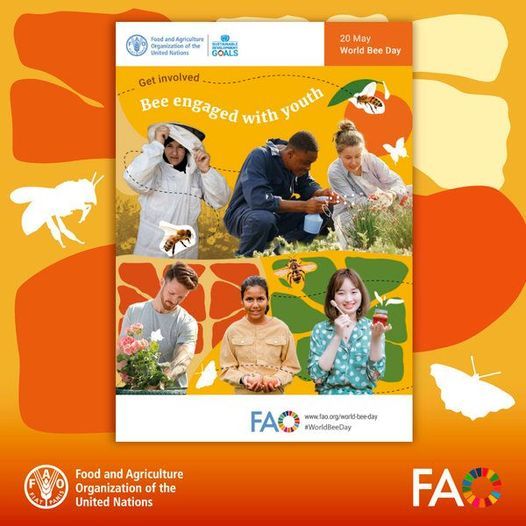
Bees are vital for our food systems and ecosystems. This World Bee Day year’s theme, “Bee engaged with Youth,” highlights involving young people in beekeeping and conservation.
#world bee day#fao#bees#awareness raising#importance of pollinators#role of bees#threats bees face#sustainable beekeeping#20 may#campaign
0 notes
Text
Ways to save the bees!
Here are 3 tips to save the colonies of bees
Plant native bee-friendly plants.
Avoid chemicals that can ham bees
Create bee house and leave nesting sites.
From environmentalist, animator and ASALI Power of The Pollinators creator and director Maya Penn and the Food and Agriculture Organization of the United Nations (FAO) on how you can save our real world bees and other power pollinators!

#bee friendly flowers#bee friendly plants#flowering plants#chemicals#nesting sites#ground nesting bees#bee hive#world bee day#Time to act#fao#food and agriculture organization#20 may#save the bees
0 notes
Text
Highlight the importance of involving young people in beekeeping and pollinator conservation efforts.
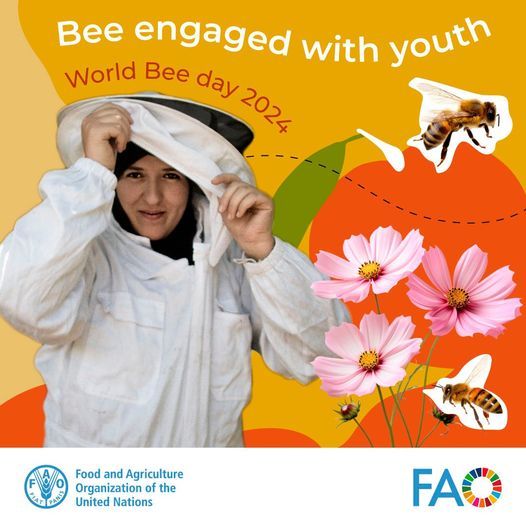
This year's theme is "Bee engaged with Youth" to highlight the importance of involving young people in beekeeping and pollinator conservation efforts, recognizing them as the future stewards of our environment.
0 notes
Text
Celebrating the vital role bees play in our lives.

Our very existence depends on bees and other pollinators. They increase food production, give us honey and nutritious food, and help maintain biodiversity.
On Monday’s World Bee Day, join us in celebrating the vital role bees play in our lives.
#beekeepers#bees#pollination#beekeeping#world bee day#20 may#unhq#honey bees#bumblebees#role of bees
0 notes
Text
Buy-honey and bee products locally.

According to some people local honey will cure your allergies, and others are simply into locally grown products. Whether you want to reduce your carbon footprint or support local agriculture, buying honey that's made by local bees is not a bad idea. “Bee engaged with Youth”. World Bee Day 2024.

#local agriculture#carbon footprint#bee products#honey#honey production#bee engaged with youth#20 may#world bee day#consumers#engaging farmers
0 notes
Text
Leave nesting sites for ground-nesting bees.

WHAT ARE GROUND NESTING BEES?
Bee careful where you walk — there’s a universe of bees underfoot! Though you may think most bees live in hives like honey bees, 70% of the world’s 20,000 bee species actually live largely solitary lives and lay eggs in underground nests.
WHY IS IT IMPORTANT TO PROTECT GROUND DWELLING BEES?
While honey bees pollinate one third of the food we eat, native bees are responsible for pollinating 80% of the world’s flowering plants. Countless ecosystems depend on their hard work, but pesticides, loss of habitat, and climate change are just some of the factors that threaten their survival around the world.
The Xerces Society posits that more than ¼ of North America’s 46 bumble bee species — all ground nesters — face some degree of extinction risk. In fact, in October of 2021, it was determined by the U.S. Fish and Wildlife Service that the American Bumble Bee could qualify for protection under the Endangered Species Act because its population has dropped nearly 90%.
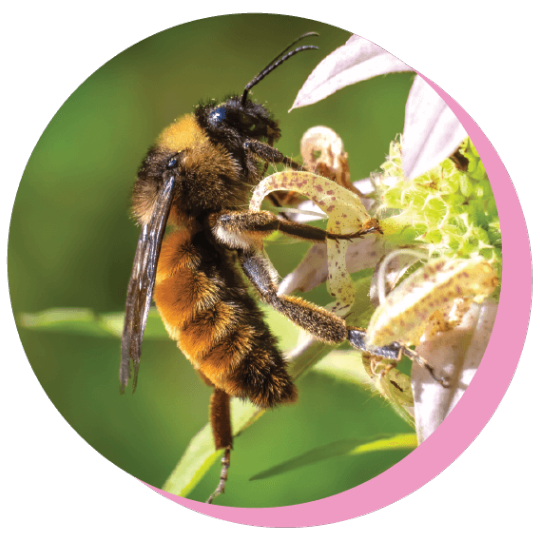
Is the American Bumble Bee (Bombus pensylvanicus) the next endangered species?
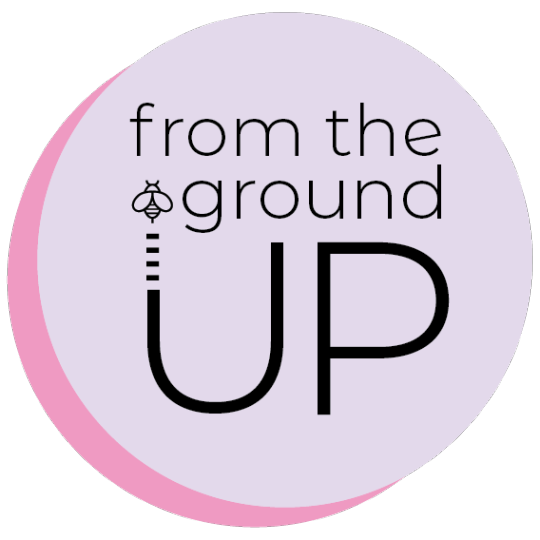
HOW IS THE BEE CONSERVANCY HELPING GROUND BEES?
Our 2022 campaign is called From the Ground Up, and is focused on education, action, and advocacy for our ground nesting friends. This is the first time TBC has launched a deep focus on protecting ground bees — and we’re so excited! Initiatives on our roadmap include building habitat, developing content, and exploring research and community partnerships that advance ground bee security.
WHAT CAN YOU DO TO PROTECT GROUND NESTING BEES?
Lending a hand to ground-nesting bees is easier than you
think! Here are some easy ways you can help:
– Let autumn leaves lie until spring, as they provided much
needed cover to underground nests.
– Go mulch-free in an area of your yard, as the barrier prevents
bees from digging down into the soil.
– Support legislation that curbs harmful pesticides, such as this
petition for New York to ban some uses of neonicotinoids.
– Check out our guide on 10 Easy Ways to Save the Bees.

Calling all friends of ground-nesting bees!
You too can help!

#neonicotinoids#ground-nesting bees#American Bumble Bee#beekeepers#bees#beekeeping#bee engaged with youth#engaging farmers#world bee day#20 may
0 notes
Text
join the buzz!
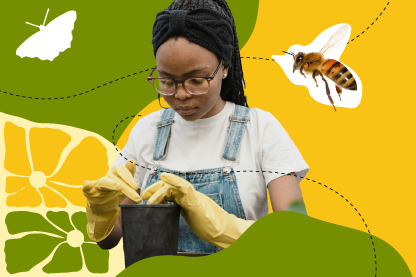
Interpreting the Buzz of Honeybees. Yes, bees buzz. But careful attention reveals there is a difference in their sounds. “Bee engaged with Youth”. World Bee Day 2024.

0 notes
Text
Opt for organic sustainable food choices.
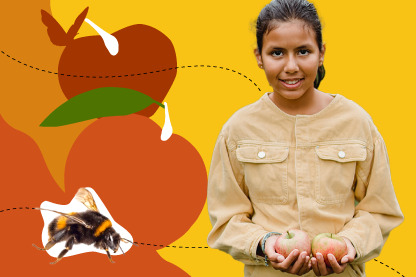
“Bee engaged with Youth”. World Bee Day 2024.
Organic Ingredients are defined materials originating from crops derived from organic agriculture. The USDA defines Organic Agriculture as :" Organic agriculture is an ecological production management system that promotes and enhances biodiversity, biological cycles and soil biological activity. It is based on minimal use of off-farm inputs and on management practices that restore, maintain and enhance ecological harmony." It is a farming system based following the cyclical patterns of nature to produce crops from balanced living soils. It puts a strong emphasis on the protection on the environment, and by practice, bans the use of Pesticides, harmful chemicals and genetically modified crops. It relies heavily on biodiversity promoting a diverse range of plants, insects and animals, with each piece, playing a specific beneficial role to the ecosystem. This is especially true for the bees, as they play a crucial role in pollination, which enables fertilization and reproduction of plants. Without the input of bees, the food and agricultural output is decreased by 33%, making only 2/3 of the food production possible. As ecology defines, sustainability as how biological systems remain diverse and productive, It can be presumed that in fact bees are actually essential to global food sustainability. Their loss is considered a threat to global food supplies and sustainability.
The current disappearance of bees, a peculiar phenomenon labeled called Colony Collapse Disorder has perplexed scientists and Beekeepers now for the past decade. However, a new study from Harvard University, published in the June edition of the Bulletin of Insectology has recently found that, neonicotinoids, a class of insecticides and pesticides allowed in agriculture, are killing bees at an exponential rate. The study finds the neonicotinoids to be the direct cause of the colony collapse disorder and the disappearance of the bees.

The study also found that the control bees, which were not exposed to the pesticides were not affected adversely and did not vanish from hives at the end of the study. It is then concluded that the focus on natural ecosystems and native species, as well as the lack of pesticides used in organic farming, is therefore beneficial to bees. By supporting biodiversity and balanced ecosystems for the bees, organic agriculture may just be helping conserve the livelihood of bees and allow for their continuous participation in our food systems. This highlights the growing importance of producing and consuming crops issued from organic agriculture to maintain bees ecosystems and food sustainability for humans. As chemists and brands , a quintessential part of the food and consumer product lifecycle, select raw materials to include in product development efforts, it will become increasingly important to consider organic options as a pillar for overall and global sustainability efforts. It seems that we are all related in our global ecosystem and various choices made have an ecological impact on the planet and our collective livelihood. Perhaps now is the time to consider adding additional criteria to the selection of product raw materials beyond pricing and quality.

#bees#young beekeepers#beekeeping#bee engaged with youth#world bee day#20 may#Bulletin of Insectology#organic agriculture#Beneficial to bees#sustainable beekeeping#sustainability#neonicotinoids#harvard university#bees ecosystems#ecological impact
0 notes
Text
What make a flower bee-friendly?
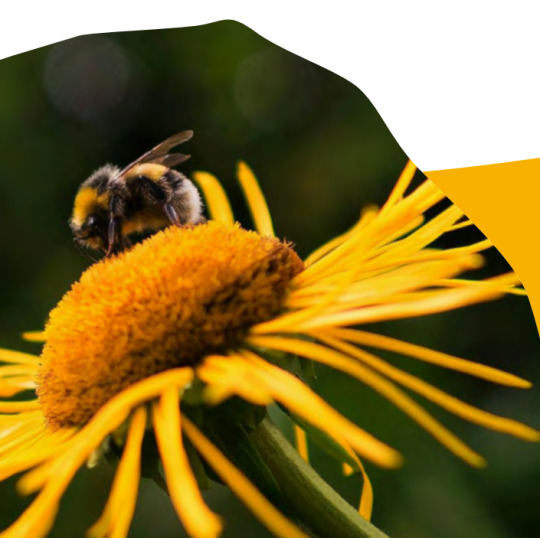
It provides a healthy diet. Flowers that attract bees provide abundant nectar and pollen, the only sources of carbohydrates and protein in a bee’s diet. While some bees, called “generalists,” aren’t picky about the type of flower, others are “specialists” and need pollen from particular plants.
It’s the right color. If you thought red or yellow was a bee’s favorite flower color, guess again. They actually see flowers in the blue and purple color spectrum better than other hues and are naturally attracted to them. (Interestingly, flowers in the blue-purple range produce the most nectar.) Bees can also see ultraviolet light, and many flowers have ultraviolet nectar guides that are invisible to us but lead bees right to their sweet treat.
It’s the perfect shape. Some bees prefer certain flowers because of their shape. Often these preferences are determined by the length of a bee’s tongue. For example, long-tongued bees seek out tubular, deep-throated blooms while short-tongued species visit flowers with easily accessible nectar, such as those in the daisy family.
It's just the right size. Sizewise, honeybees often flock to tiny flowers, while larger bees shun them because they are too small to support their weight.
It's single. Regardless of flower shape or size, avoid cultivars with showy double flowers. While attractive, they often make it more difficult for bees to access nectar and pollen than single flowers.
It’s chemical-free. Don't treat your flowers with pesticides, which are extremely toxic to honeybees and other beneficial insects. Instead, opt for eco-friendly treatments and apply them in early morning or at dusk when there are few bees around. Also, avoid buying plants pretreated with systemic chemicals that, even in small doses, can be harmful to bees.
It blooms at the right time. Although spring and summer may seem to be when bees are at their busiest, some early-emerging bees rely on pollen and nectar from late winter and very early spring blooms. In the fall, bees feast on late-blooming plants in preparation for winter hibernation.
Early-season bloomers: Crocus, hyacinth, primrose, hellebore, maples, redbuds, willows, oaks, and dandelion
Late-season bloomers: Potentilla, viburnum, aster, sunflower, goldenrod.
Join the virtual event entitled “Bee engaged with Youth” to celebrate with us the World Bee Day 2024!
#crocus#hyancinth#primerose#mapples#redbuds#willow#oaks#dandelion#potentilla#viburnum#sunflower#blue globe allium#stiff goldenrod#bees#flowering plants#honey bee#bee friendly flowers#bee engaged with youth
0 notes
Text
Plant bee-friendly flowers.

“Bee engaged with Youth”. World Bee Day 2024.
Bees help your garden thrive, so treat them well by growing some or all of these bee-friendly plants. Which came first, the bee or the bee balm? While the question may be interesting to contemplate, it illustrates the vital partnership between plant and pollinator, and how one needs the other in order to survive.
Bee populations are declining rapidly in many regions of the country, with habitat loss being a primary cause. As gardeners, we can do our part to help keep these important pollinators well fed. Growing a diverse variety of flowering plants can satisfy the appetites of various bee species. Along with planting lots of flowers that attract bees, we can also improve the environment for bees by creating a safe haven in our gardens that they can call home.
#bees#world bee day#20 may#bee-friendly flowers#Bee engaged with youth#bee balm#blue globe allium#oriental poppy#coneflower#great blue lobelia#catmint#new england aster#lavender#chives#sunflower#stiff goldenrod#borrage#zinnia#joe pie weed#flowering plants
0 notes
Text
Plant hedgerows.

“Bee engaged with Youth”. World Bee Day 2024.
Which Hedge Plants Are Best For Bees?
All native plants, which make up our conservation hedge mixes, are great for bees, especially blackthorn and hazel, which open their flowers and catkins before most other trees and shrubs.
The other native classics are Hawthorn, Crab Apple, Dog Rose, Common Dogwood & Red Dogwood, Field Maple, Guelder Rose, Spindle, Sweet Briar Rose or Wayfaring Tree.
By mixing several varieties together (five is a good number), you ensure a good spread of flowering times.
Honey bee hives do not really hibernate; they are active on warm winter days, so plants that flower in cold weather are extra important.
Other great hedge plants for bees include:
Viburnum tinus Eve Price (Winter flowering)
Rosemary (Summer flowering)
Forsythia Spectablis (Winter flowering)
King Edward VII Currant (Early-Spring flowering)
These plants are too small or low growing to be a privacy hedge, but they are perfect for low ornamental hedging / edging.
Lavender (Summer flowering)
Sweet Box - Sarcococca confusa (Mid-Winter flowering)

#world bee day#Hawthorn#Crab Apple#Dog Rose#Common Dogwood#Red Dogwood#Field Maple#Guelder Rose#Spindle#Sweet Briar Rose#Wayfaring Tree#blackthorn#hazel#Viburnum tinus Eve Price#Rosemary#Forsythia Spectablis#King Edward VII Currant#Sweet Box#vender
0 notes
Text
Strengthening the science-policy interface on pollination.

This Assessment covers changes in animal pollination as a regulating ecosystem service that underpins food production and its contribution to gene flows and restoration of ecosystems. It addresses the role of native and exotic pollinators, the status of and trends in pollinators and pollination networks and services, drivers of change, impacts on human well-being, food production of pollination declines and deficits and the effectiveness of responses to pollination declines and deficits. The Assessment informs enhanced policy responses to declines and deficits in pollination by identifying policy-relevant findings for decision-making in government, the private sector and civil society, as well as helping to demonstrate how an essential ecosystem service contributes to the 2030 Agenda for Sustainable Development.
The Plenary approved the Summary for Policymakers and accepted the chapters of the Assessment at its 4th session in February 2016 in Kuala Lumpur, Malaysia (IPBES 4). As the first of the completed IPBES thematic outputs, the publication of this Assessment has generated a wide range of follow-up products, actions and policy initiatives. Some of the most noteworthy of these are:
A formal endorsement of the key messages of the Assessment by the Conference of the Parties to the Convention on Biological Diversity at its 13th meeting (COP13).
The formation of a “Coalition of the Willing” by a growing number of Governments around the world, inspired by the assessment to act nationally to protect pollinators and to promote pollination.
The publication, in both the Nature and Science journals, of major articles building on and reviewing the assessment. Access the media releases.
An ever-expanding list of national strategies and action plans on pollination, premised on the outcomes of the assessment, in countries including, among others: France, the Netherlands, Brazil, South Africa and the Republic of Korea.
IPBES would like to acknowledge and thank all of the experts who contributed to the Assessment, and whose efforts have already made so great an impact in strengthening the science-policy interface on pollination.
#national strategies#Action plan#pollination#ipbes assessment report on pollinators#beekeepers#crops production#food production#sdg15
0 notes
Text
Check out a few facts about pollinators!

The Pollinators are responsible for much more than food-crops. From biofuels to medicines, we rely on pollinators in much of our daily lives.
Few facts about pollinators. IPBES Pollination Assessment.
0 notes
Text
Raising awareness of bees' contributions to environmental and social resilience.
“World Bee Day has contributed significantly to raising awareness of the importance of bees and other pollinators and to promoting international cooperation to protect them,” said Nataša Pirc Musar, President of the Republic of Slovenia.
Her country initiated the establishment of a World Bee Day in 2016 at an FAO regional conference for Europe and co-created more than 300 pollinator projects with partners on all continents, she said.
For its part, the United Nations marked World Bee Day 2023 with an FAO-hosted global ceremony emphasizing the importance of these hard-working pollinators.
Under the theme of pollinator-friendly agricultural production, the event drew attention to the threats endangering these insects and the need to address them.
On Monday, an event at United Nations Headquarters will showcase best practices and innovative projects with a view to raising awareness of bees' contributions to environmental and social resilience.
“Protecting bees and other pollinators is essential to guarantee agricultural production, food security, ecosystems restoration, and plant health,” FAO Director-General Qu Dongyu said.
As beekeeper Ms. Moreno Veliz said, “bees are extremely intelligent insects. They are beautiful animals.”
#pollinator projects#Ensuring bee health#Pollinator-friendly practices#bees habitat#protect bees#Agricultural tool and innovation#pollinator
0 notes
Text
65 % of the plants on the planet require pollinators.

The National University of Costa Rica estimates that 65 per cent of the plants on the planet require pollinators, and of these, the most important are bees.
0 notes
Text
Pollinator-friendly practices include crop rotation and diversity, reducing the use of pesticides, and restoring and protecting their habitat.
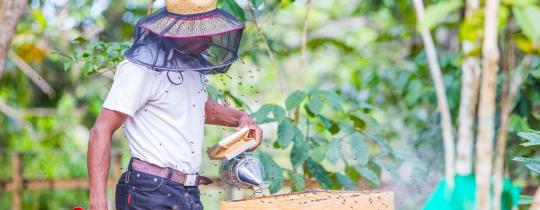
Ensuring bee health is a goal of the United Nations food agency, especially in light of threats against them, including unsustainable agriculture, pesticide abuse, and intensive monoculture production.
Pollination is essential for the maintenance of plant biodiversity, the survival of the world’s ecosystems, with about 75 percent of crops – which produce fruits and other seeds for human consumption – depending, at least in part, on pollinators, including bees, FAO said.
Pollinator-friendly practices include crop rotation and diversity, reducing the use of pesticides, and restoring and protecting their habitat. Even the adoption of precision agriculture tools and innovation can protect bees, the agency said.
To help to better protect the pollinators, the agency hosted and co-organized on Thursday the second International Symposium on Biosecurity in Beekeeping, bringing participants up to date on the latest developments in bee biosecurity and the initiatives that the international organizations involved are applying in different areas of the world to ensure bee health.
#Ensuring bee health#Pollinator-friendly practices#bees habitat#protect bees#Agricultural tool and innovation#pollinators#bees#bee biosecurity#BEEKEEPERS#Bee biosecurity
0 notes
Text
If beekeeping is taken to a level where farmers understand it as a business, it’s going to improve their livelihoods.
Betty Ayikoru, from Arua district in Uganda, is mother of four, a farmer, local councillor, and a beekeeper.
“That’s how I make a living,” she said.
She works with Honey Pride Arua, a social enterprise founded by Sam Aderubo and supported by the United Nations Capital Development Fund (UNCDF).
Like many others, her life has improved thanks to skills training, and the sustainable market provided by the business. Now, more than 1,700 farmers keep their bees in apiaries and at harvest time, they sell to Honey Pride.
“By engaging farmers, we are giving them alternative employment,” Mr. Aderubo said. “If beekeeping is taken to a level where farmers understand it as a business, it’s going to improve their livelihoods.”
youtube
#United Nations Capital Development Fund (UNCDF)#uganda#sustainable market#skills training#beekeepers#beekeeping#engaging farmers#apiaries#Youtube
0 notes